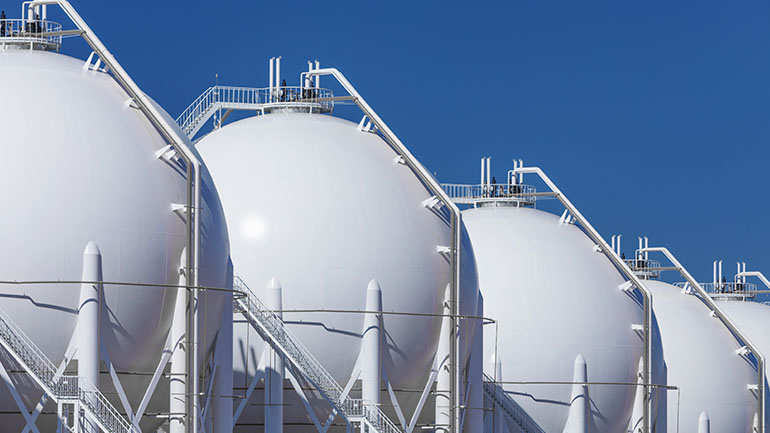Reshuffling the global gas market
By: Ryan McKay
April 4, 2022 - 5 minutesCan Europe deal without Russian gas flows? We examine how the Russia-Ukraine war is impacting global gas supply, and what options exist to continue to meet supply and demand.

A large component of their plan focuses on turning to the global Liquified Natural Gas (LNG) market. However, there are constraints in the LNG market which can limit the feasibility of such plans in the near-term. Issues spanning Europe's import capacity, to global suppliers' ability to increase or re-route supplies suggests Europe will have a hard time immediately offsetting Russian supply and are likely to face structurally higher prices that could persist for years.
Notably, price action in North American markets has been more muted in response to the ongoing war and growing supply risks. With LNG feedgas demand already being maxed out, the follow-through mechanism from global prices into the U.S. has already largely run its course. But Europe shifting away from Russia and toward more global LNG supply can certainly create a more favourable landscape in the U.S. for additional LNG export capacity down the road.
Can Europe deal without Russian flows?
Firstly, flows on the Yamal-Europe pipeline (from Russia through Poland and into Germany at the Mallnow entry) have been mostly at 0 since mid-December. While these flows have been shut for months, the longer these flows remain halted, the more pressing it becomes for Europe to find an offset to prevent even further tightening of market balances. At the same time, the sanctions and indefinite halting of Nord Stream 2 had no impact on immediate flows as the pipeline had regulatory setbacks that meant flows were unlikely until Q2 or Q3 2022. But the sanctions do have implications on supply expectations from the summer onward as that supply was baked into analyst forecasts.
Conversely, Nord Stream 1 has remained operational as normal throughout the conflict, although Former Russian Minister of Energy and acting Deputy Prime Minister Alexander Novak has threatened the halting of these flows.
Finally, flows through Ukraine to the Velke-Kapusany entry point in Slovakia have held up thus far, but we view these flows as the greatest risk to disruption, particularly considering the potential for damages as war rages on in the country.
With that said, the EU's plan calls for a 50 Bcm (roughly 6.5 Bcf/d) increase in LNG imports by the end of 2022 to offset Russian imports. Furthermore, based on recent pipeline flow data, if Russia were to retaliate and halt all flows from the previously mentioned Mallnow, Nord Stream 1 and Velke Kapusany pipelines, the number to offset would be closer to 9 Bcf/d.
This article is an excerpt from our full report on global gas supply. Subscribing clients can read the full report on our Market Alpha Research Portal
Will LNG's import capacity be enough to offset Russian supply?
The other issue is the actual availability of supply for Europe to import. Strong appetite from Europe during the winter saw U.S. exports running at near full capacity while U.S. LNG export capacity expanded in the early months of the year as new projects came online.
Furthermore, Europe already purchased some 60% of U.S. LNG. The remaining shipments are tied to long-term contracts to buyers with less price sensitivity, suggesting little flexibility for more shipments. Qatar and other suppliers have also noted difficulties in increasing or re-routing shipments in the immediate term. Over 70% of LNG supply is tied up in long-term contracts to Asia, the Middle East and elsewhere to ensure their own domestic demands are met. Europe can only price itself into contention to attract un-contracted and divertible LNG supply. Even then, the LNG that is available is not guaranteed to find its way to Europe as there will be fierce competition with Asia for supplies.
Near-term pain for long-term gain?
While we are not optimistic about Russian supply being offset in the near-term, the proposal could work on a multi-year horizon. For example, the U.S. LNG expansion in recent years has allowed Europe's reliance on Russian gas to fall from 50% in 2019 to around 25% today. Certainly, expansion of regasification and pipeline capacity in Europe combined with an additional wave of U.S. LNG export capacity would make the task more manageable. However, even with timelines brought forward and an attractive market, these projects would not be in operation until 2024-25, which suggests disruptions to Russia supply are likely to see gas prices remain elevated, if not spike higher still.
Learn more about products and services offered by our global strategy team

Commodity Strategist, TD Securities

Commodity Strategist, TD Securities

Commodity Strategist, TD Securities

